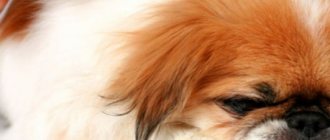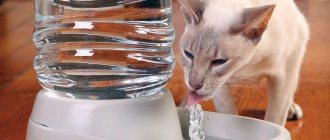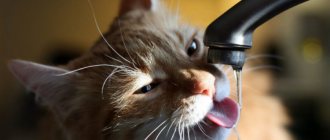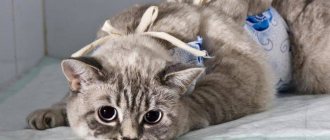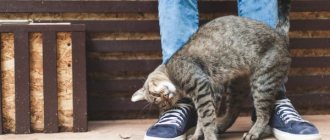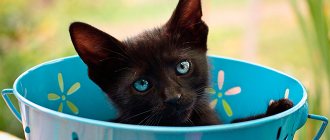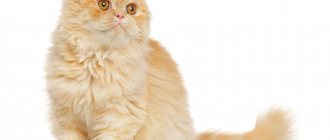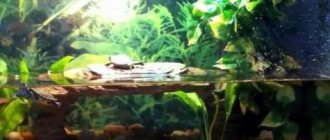- Excessive fluid intake - how to recognize it?!
- Why does a cat drink a lot of water?
- How to make sure your pet has enough water?
- Diseases that cause increased water consumption
- How to know how much water your cat should drink
Each phenomenon has its own causes and consequences.
And each manifestation of ill health has its own prerequisites. Cats cannot tell their owners what is wrong with them, and humans must monitor the health of their furry pet. Sometimes people notice that their cat drinks a lot of water. There can be many factors for this, and first of all you need to find out whether the problem is due to health or other reasons. Often cats not only drink a lot, but also urinate more.
Excessive fluid intake - how to recognize it?!
The amount of liquid cats drink is affected by the ambient temperature. In hot weather, the cat eats little and drinks a lot. Physical activity and other factors should also be taken into account.
If you think your cat is drinking too much, compare the amount he drinks with the usual amount. Remember, maybe he drinks a lot because yesterday his bowl was half empty, or you transported him, and he steadfastly endured all the hardships of a cat’s life, and as a result did not drink water all day.
If you still suspect that something is wrong with the cat, take him to the veterinarian and undergo a medical examination.
Reasons for refusing water
There are many reasons why a cat refuses water. Not all of them are a cause for concern. Even a healthy animal can refuse food for completely physiological reasons.
For example, kittens that receive their mother's milk do not drink. In this case, there is no need to solder them. Everything that a small organism needs, it gets with the cat's milk.
Animals that eat natural products and receive soups, kefir, eggs, milk, and cottage cheese drink little, sometimes unnoticed by their owners. Pets who eat wet food and pates drink little. If an animal eats dry food, it definitely needs additional drink, otherwise irreversible processes will begin in the body.
Refusal to drink water can also be behavioral in nature. Water consumption or a cat's thirst is an individual issue; some cats simply don't drink enough
But if your pet suddenly stops drinking water, this is worth paying attention to.
An animal may refuse to drink if it does not like the bowl. Some cats do not want to drink if there is a bowl of food next to the water bowl. While eating, even the most careful pets splash wet food or, while chewing “crackers,” drop crumbs. Pieces of food may fall into the water. Disdainful pets do not consider such water clean, and they refuse it.
Cats may refuse to drink boiled water. Such water is not good for animals, bacteria multiply quickly in it, and its taste also leaves much to be desired. You should not give cats distilled water. This will only bring harm.
Cats may refuse to drink tap water after the water has been actively disinfected at the filtration station. People don't always smell the smell of disinfectants. Or if he hears it, he ignores it, but the cat may refuse such a drink.
A pet may refuse water if it is poured into an unwashed bowl or if the water has not been changed for too long. Such water acquires an unpleasant odor that even a person can detect, let alone an animal whose sense of smell is 15 times sharper.
If a cat categorically refuses to drink, it needs to be shown to a veterinarian. You will have to visit a doctor as soon as possible if, in addition to refusing to drink, the cat does not touch food, becomes weak, apathetic, and develops new symptoms of illness. This may be a sign of illness. For example, a characteristic symptom of rabies is hydrophobia. Usually, refusal to drink due to illness is accompanied by refusal of food, deterioration of the animal’s well-being, apathy and weakness.
An animal may not drink if there is massive blood loss. The cat is simply unable to drink, in which case it needs emergency medical attention. With external bleeding, the signs are obvious. When internal, the animal is weakened, the visible mucous membranes are pale, the animal may lose consciousness.
An animal may not drink if it has multiple organ failure, liver or kidney failure. The cat is constantly sick, she is very weakened, and vomiting.
In case of oral injuries or a broken jaw, the animal may refuse to drink. The cat does not drink not because she is not thirsty, but because drinking is very painful for her. At the same time, the animal refuses to eat.
When tumors grow, in particular, when there is a tumor on the tongue, the cat refuses to drink and water because he cannot eat. The tongue increases in size, does not fit in the mouth, and is injured by the teeth. The cat's salivation increases.
Infectious diseases accompanied by ulceration of the oral mucosa, for example, calcivirosis, can lead to the fact that the animal drinks little and reluctantly. This disease is accompanied by fever, rhinitis, and intestinal disorders.
Why does a cat drink a lot of water?
If you and your veterinarian believe that your cat drinks too much, the animal will be prescribed a general urine test, biochemical and general blood tests, and may also need an endocrinological examination and ultrasound diagnostics.
Here are some of the reasons that often cause constant thirst in animals:
- Diabetes mellitus and diabetes insipidus
- Hyperthyroidism - excess function of the thyroid gland
- Insulinoma
- Acute and chronic renal failure
- Pyelonephritis
If your cat begins to drink a lot of water, do not limit it or remove the water bowl. This can cause a lack of fluid in the body. Dehydration is very dangerous.
Why does my cat become more thirsty?
When a cat drinks a lot, you need to find out what caused her thirst to increase. Physiological and pathological factors can provoke this phenomenon. The former do not require any special measures to be taken; the latter, on the contrary, require an immediate visit to a veterinary clinic, whose specialists will confirm or deny the presence of the disease and, if necessary, prescribe treatment for the four-legged patient.
Physiological causes and influence of external factors
Typically, increased thirst in felines is caused by harmless reasons. Some of them cannot be called such, but they cannot and do not need to be corrected with treatment. We are talking about the natural decline of the body. If an old pet starts drinking a lot of water, this does not mean at all that there is something wrong with him, this is just a sign of a slowdown in internal processes.
Why does a healthy, mature cat or kitten constantly drink water? This may happen due to:
- Excessive physical activity. Long walks and active pastime increase thirst.
- Warm season, high air temperature in the room in which the cat is constantly located. In the heat, cats, like people, increase their need for water.
- The period of gestation and feeding of cubs with breast milk. In almost all pregnant and lactating pets, their owners observe an increase in thirst.
- Age. As noted earlier, kittens do not require as much fluid as mature animals for the normal functioning of their bodies. Older individuals, on the contrary, want to drink a lot and often. Many owners of older cats have probably noted that they urinate more often than at a younger age. This is precisely caused by increased water consumption.
- Nutritional features. Animals that eat high-quality ready-made food drink less water and, accordingly, pee less often than their counterparts who eat lower-quality foods. Thirst in cats whose diet consists of dry food is higher than in those whose diet consists of wet canned food. The situation is similar with pets who often eat liquid natural food. If you feed your four-legged pet foods that are too salty, his body will naturally experience an increased need for moisture.
- Increased body weight. Animals with greater weight drink more water than their slimmer relatives. This reason can hardly be considered harmless, since an increase in a cat’s weight inevitably entails other, more serious problems with its health.
- Taking certain medications. Increased thirst can be a side effect of diuretics, sedatives, painkillers, and corticosteroids.
- Diarrhea. Diarrhea cannot be considered a pathological phenomenon only if it occurs once. Repeated loose stools require therapeutic measures.
Pathological causes, diseases causing polydipsia
An unnaturally strong, unquenchable thirst is called polydipsia. If excessive activation of the drinking center in the cat's brain was caused by some pathology, in addition to this symptom, there will be other signs of the disease. Typically, a sick pet eats little or not at all, becomes very weak, rarely goes to the toilet, and does not respond to external stimuli. Increased thirst is just one of the signs of the disease.
Polydipsia in cats can be caused by the following pathological factors:
- Diabetes. Stopping the pancreas from producing the required amount of insulin leads to a disruption in the supply of glucose to the kidney cells, due to which they lose the ability to fully filter moisture, and the animal quickly loses it.
- Chronic renal failure, which is often diagnosed in older cats, is when the kidney cells stop working properly and retain the required amount of fluid.
- Hepatitis.
- Inflammation of the pancreas, which is detected quite rarely in representatives of the cat family.
- Diseases of the central nervous system in which the process of activation of the drinking center in the cat’s brain is disrupted.
- Infections.
- Purulent inflammatory process in the abdominal organs.
- Inflammation in the organs of the reproductive system.
- Dropsy, characterized by the accumulation of fluid in the tissues.
- Severe emotional shock.
- Pathological processes in the brain.
Diseases that cause increased water consumption
If your cat begins to drink a lot of water, and you have ruled out natural causes (heat, taking medications, switched to dry food), there may be an underlying disease.
Most often this is:
- Diabetes mellitus or diabetes insipidus. Although this disease occurs frequently in humans, it also occurs in cats. If you suspect this disease, you need to show the animal to a specialist. If the functioning of the pancreas is disrupted, the level of glucose in the blood increases, while the kidneys work harder, diuresis becomes more frequent, and the animal becomes thirsty. To make a diagnosis, a laboratory test of blood, urine, ultrasound examination of the pancreas and a blood test for hormones are required.
- Chronic renal failure. This kidney dysfunction can occur due to various reasons. Among these reasons are hereditary ones, as in the Persians, for example, as well as improper feeding and age-related changes. A purely fish diet is especially dangerous for a cat; fish contains a lot of minerals, and the body does not have time to absorb them. Some of these substances begin to deposit in the kidneys in the form of stones. If this disease is suspected, blood tests, urine tests and ultrasound of the genitourinary system are prescribed.
Natural causes of increased thirst
Let's look at some benign, healthy causes of increased thirst in cats. This:
- dry food
- pregnancy
- increased physical activity (hyperactive cats always drink much more)
- very dry air in the apartment (especially in winter. However, with this factor, the cat exceeds the daily dose of water consumption very slightly)
- hot weather
- the presence of diuretic products in the feed (with natural nutrition)
- excessive salt content in cat food (one of the thousands of reasons why cats do not like food from our table)
- rare, but still caused by protein deficiency
- taking diuretics and corticosteroids
- stress (although it is not a healthy manifestation, we will classify it as a non-dangerous cause, since it is not a physical pathology that must be treated immediately). Cats that are overexcited, very frightened, or have experienced shocks often drink more than in a calm state.
How to know how much water your cat should drink
On average, a cat needs about 200 ml of water per day, which corresponds to 20-40 ml per 1 kg of animal weight. In order to know the physiological needs of your pet, it is better to constantly monitor how much he drinks in a normal environment for his body. Measure how much water you pour into your cat's container. The next day, measure how much is left. If you added water several times, take these amounts into account when measuring. In a few days it will become clear how much water a cat needs on average every day.
And if the deviation becomes large, you will need to look for the reason why the cat drinks a lot, whether it is caused by an illness. Or she simply accidentally ate a piece of herring, or was too active on hot days, and is now compensating for the lack of water.
Serious reasons
Lethargy and lethargy in a cat is often a sign of a serious illness, but in order to know for sure, you need to pay attention to additional signs. If lethargy is caused by pathology, it is usually accompanied by the following symptoms:
If lethargy is caused by pathology, it is usually accompanied by the following symptoms:
- The desire to hide in a dark place.
- Ungroomed fur.
- Diarrhea and vomiting.
- Lack of appetite and reluctance to drink.
- Heavy, shallow, or excessive breathing.
- Aggression.
- Increased body temperature.
- Shiver.
If a cat exhibits similar symptoms along with lethargy, then most likely it has one of the following conditions.
Stress
It cannot be called a disease; it would be more correct to say that it is a pathological condition caused by certain reasons, for example, a mental disorder, a change of owner, moving to a new place, the appearance of a new pet in the house, etc. Characteristic symptoms of stress are: eating disorders (refusal to eat or overeating), agitation, excessive licking of fur, scratching furniture, etc.
High or low blood pressure
Low blood pressure (105/65 - 135/95 mmHg), as a rule, is accompanied by lethargy, its signs: drowsiness, apathy, loss of appetite, nausea, loss of consciousness. Signs of high blood pressure: dilated pupils, red eyes, blurred vision.
Endocrine system diseases
For example, diabetes mellitus, Cushing's disease, hormonal imbalance after childbirth, etc. Signs of endocrine disorder: extreme thirst, loss of appetite, frequent urination, bloating, dull hair, lethargy, weakened muscle tone, cramps.
Diseases of the musculoskeletal system
They are characterized by: refusal to jump, excessive caution of movements, causeless lameness (in the absence of injuries), swelling of the joints, apathy, refusal to eat, unkempt fur. Sometimes such diseases are accompanied by causeless aggression and growling, which is a sign of severe pain.
Infectious diseases
Such as panleukopenia, rhinotracheitis, calcivirosis. Signs of an infectious disease may include: diarrhea with the formation of yellow-green or greenish stool, coughing, sneezing, vomiting, hoarseness and difficulty breathing, excessive discharge from the nose and eyes, pallor or redness of the mucous membranes.
Oncological diseases
Characteristic signs are: bad breath, the appearance of non-healing ulcers on the skin and swelling on the body, aimless wandering around the house, diarrhea or vomiting, rapid weight loss, plaintive meowing, refusal to eat.
Presence of parasites
Such as fleas, worms and ticks can manifest themselves in stool disorders, weight loss, flatulence, purulent discharge from the eyes, bloating, etc. Ear mites manifest themselves in the fact that the cat constantly shakes its head, scratches its ears, from which a large amount of amount of earwax. Ticks on the skin of an animal provoke the appearance of itchy wounds and scales, as well as bald patches and itchy skin, and fleas also manifest themselves in the same way.
Inflammatory diseases of internal organs
They are accompanied by the fact that the cat becomes apathetic, drowsy, and refuses to play and eat. Diseases such as pyelonephritis, urolithiasis, cholecystitis and pancreatitis, as well as gastritis and colitis can cause an increase in body temperature in the animal, the appearance of blood in the urine and feces, and stool and urination disorders. When the cat has inflammation of the oral cavity, there is profuse salivation, the gums become swollen and red, and the appetite decreases.
Lack of vitamins (hypovitaminosis)
It has the following signs: dull fur, the presence of dandruff and dermatitis, frequent miscarriages in pregnant cats and developmental delays in kittens.
Low hemoglobin (anemia)
In this case, the animal develops weakness and apathy, cyanosis of the mucous membranes, decreased blood pressure, and deterioration in the quality of the coat.
Complications after surgery
They are characterized by: plaintive meowing, hyperthermia, lethargy, vomiting or constipation, purulent discharge from the postoperative wound.
If the cat is drowsy and apathetic for a short time (no more than 12 hours), then there is no reason to worry. Also, do not worry if the animal has been like this since childhood, as this is a sign of a phlegmatic character. If there is a sharp change in behavior and the pet has turned from cheerful to lethargic and indifferent, then this is a reason to consult a veterinarian.
The cat drinks a lot and urinates little - reasons
It happens that a cat loses fluid and drinks a lot, but at the same time the pet goes to the toilet as usual or even less. Subjectively speaking, this condition is much more dangerous than the previous ones listed. Because water needs somewhere to go, it accumulates in tissues or organs.
If the tests turn out to be normal, the animal should be closely monitored. Most likely, the reason is either a developing illness or natural needs.
A dangerous and almost hopeless condition is the formation of dropsy or ascites. The so-called effusion occurs in a body cavity, usually in the peritoneum or sternum. The animal literally fills with fluid, its organs are compressed and cannot function normally. Particularly heavy stress is placed on the heart and kidneys.
With burns, including chemical ones, the evaporation of fluid from the surface of the body increases greatly. Severe dehydration and, at the same time, increased water intake may be associated with recurrent diarrhea or vomiting. At the same time, the cat almost never goes to the toilet, only drinks.
Empty heat is a very unpleasant condition that can drag on due to hormonal imbalance. As you know, during estrus, blood is released from the cat's genitals. Normally, the blood loss is not large, but if the cat has already developed health problems, the blood loss can be quite significant. Animals that are not of breeding value are recommended to be castrated before the onset of their first heat, as this gives a great chance of keeping their hormonal levels intact.
In older animals, water consumption increases for natural reasons. Drinking water is absorbed by the body, so frequent urination is not observed. The cat begins to drink more instinctively, since saturating the body with water slows down aging and speeds up metabolism. By analogy, increased fluid consumption can be observed in a kitten during periods of active growth or increased stress.


